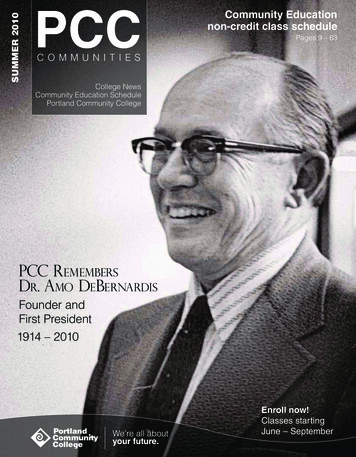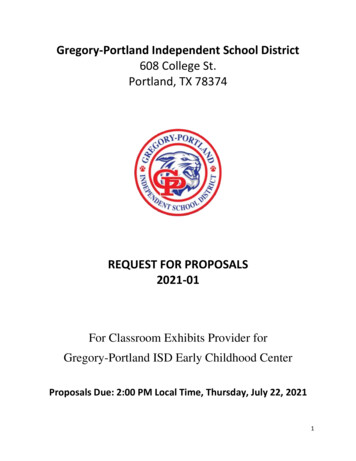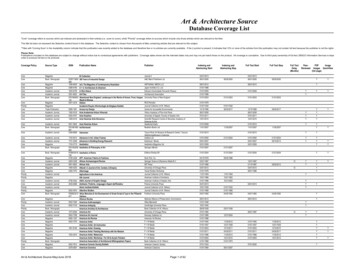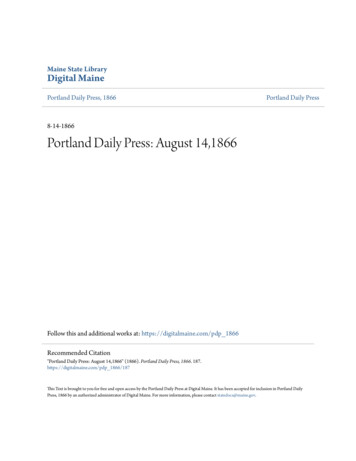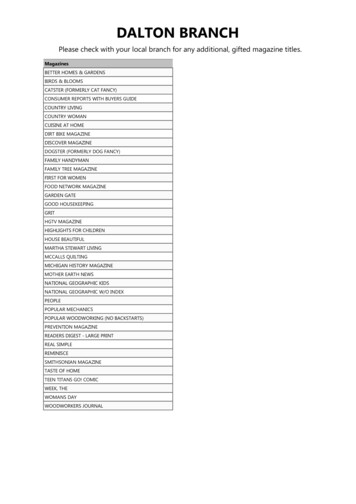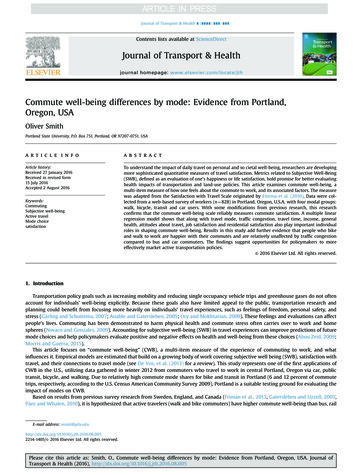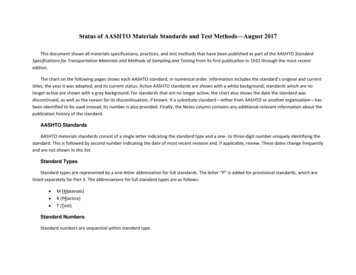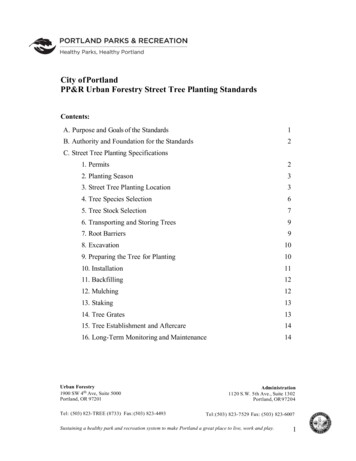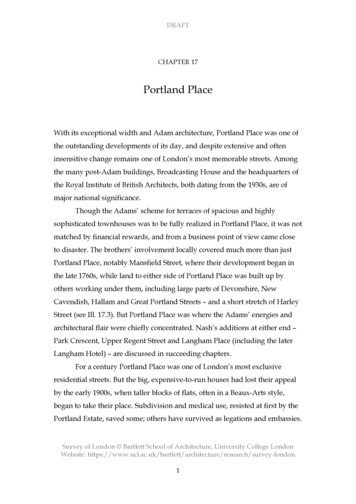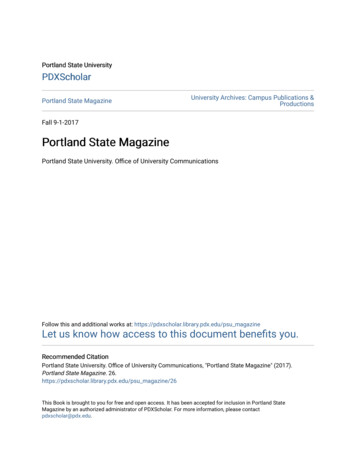
Transcription
Portland State UniversityPDXScholarPortland State MagazineUniversity Archives: Campus Publications &ProductionsFall 9-1-2017Portland State MagazinePortland State University. Office of University CommunicationsFollow this and additional works at: https://pdxscholar.library.pdx.edu/psu magazineLet us know how access to this document benefits you.Recommended CitationPortland State University. Office of University Communications, "Portland State Magazine" (2017).Portland State Magazine. 26.https://pdxscholar.library.pdx.edu/psu magazine/26This Book is brought to you for free and open access. It has been accepted for inclusion in Portland StateMagazine by an authorized administrator of PDXScholar. For more information, please contactpdxscholar@pdx.edu.
F A L L 2 0 17M O O N ST R U C KStudents document the Great American Eclipse / 12New President Rahmat Shoureshi / 10 Sharing the world / 15Open for Business / 20 Teaming up for science / 22
11.28.17give change.On Tuesday, November 28, join thousands of fellow Vikings — alumni, students,parents, friends, neighbors, faculty, and staff — to support the schools and programsthat have made a difference in your life, and advance causes and projects that willmake a difference in the lives of others.www.psuf.org/give-change
page 10CONTENTSDepartments2 FROM THE PRESIDENTA new beginning3 LETTERSEarly Ondine was coed for sureCoed housing led to true loveHomeless label disappointingLiving free in MassachusettsPSU gear hard to find4 PARK BLOCKSStarting Four Years FreeTurn on, tune in, but don’tdrop outBizarre discovery leads toNASA grantExperiments in spaceFind a tree to know its historyFilm captures unsettledresettlementRed Means HelpTiny home village complete8 FANFAREFeatures10 RELATIONSHIPBUILDER12Big win in BaliHear them for yourselfNew Works1524 ALUMNIWorking her way upthe corporate ranksAlumni in the news2026 ATHLETICSHonoring football greatArthur Dickson28 GIVINGCome to the campus for fun, free andlow-cost events; see list on pages 18-19.Donor investments transformNeuberger Hall29 LOOKING BACK22Rahmat Shoureshi begins a newera as president of Portland StateUniversity.MOONSTRUCKStudents send balloons into thestratosphere to document the GreatAmerican Eclipse.SHARING THE WORLDInternational students bring a freshperspective to their American peers.OPEN FOR BUSINESSIt’s bigger, brighter and designed totransform The School of Business.TEAMING UPFOR SCIENCEGrants enable high school teachersto partner with PSU professors.In the midst of changeON THE COVER A NASA-funded project allowed Portland Stateengineering students to record the eclipse and its shadow on the surroundingcountryside from balloons at 100,000 feet. See story on page 12.PagePORTLAND STATEFALL 20 176M AGAZ I NEVOL. 32 NO . 1FAL L 2017P O R T L AND S TAT E M A G A Z I N E1
FROM THE PRESIDENTFall 2017 / VOL. 32 NO. 1EDITORKathryn KirklandWRITERSStephanie Argy, John Kirkland,Paige ParkerPHOTOGRAPHERSKelly James, Edis Jurcys, NashCOPhotography, Peter SimonCOPY EDITORMartha WagnerDESIGNBrett Forman, Evan KirkleyLETTERS TO THE EDITOR810 Market Center BuildingPO Box 751Portland OR 97207-0751503-725-4451, fax 503-725-4465psumag@pdx.eduADDRESS CHANGESPlease go to the websitepdx.edu/alumni/contactor call 503-725-4948ALUMNI RELATIONS OFFICETom Bull, Executive DirectorSimon Benson House1803 SW Park Ave.PO Box 751Portland OR 97207-0751503-725-4948alum@pdx.eduPSU BOARD OF TRUSTEESRick Miller MBA ’91, ChairErica Bestpitch MS ’12Gale Castillo MA ’74Sho Dozono MS ’69Gregory HinckleyMaude HinesThomas ImesonMargaret KirkpatrickIrving LevinPeter NickersonSteff Shao ’16Lindsay StewartPeter Stott HD ’11Christine VernierRahmat ShoureshiPortland State Magazine is publishedthree times a year, during fall, winterand spring terms. Contents may bereprinted only by permission of theeditor. The magazine is printed onrecycled paper. Portland State Universityis an affirmative action / equalopportunity institution.2P O R TLA N D STATE MAGAZINE FAL L 2017A new beginningI AM THRILLED to serve as the ninthpresident of Portland State University. It isan opportunity that marks the culminationof my professional career and also bringsa responsibility to build upon the successesof my predecessors and the entire campuscommunity to help make PSU a top-tierurban university. I want to thank everyonefor the warm welcome I have received.Portland State has much to be proudof. What drew me here is its commitmentto civic engagement and service, theentrepreneurial faculty, the rich diversityof students, the dedicated staff andthe progressive spirit of the Portlandcommunity. I am grateful to Wim Wiewelfor his leadership in setting a high standardof excellence and accomplishment.Readers can learn about my backgroundelsewhere in this magazine. For my firstcolumn, I’d like to talk about my prioritiesand vision for PSU.My first goal this fall is to learn aboutPSU’s culture and connect with students,faculty, staff, alumni and campus leaders.With 29,000 students and more than4,000 faculty and staff, PSU is a city initself.Over the long term, I would like tofocus on key areas of strength and developstrategies to broaden resources that willexpand upon such areas as: Access: I strongly believe that anystudent who has the academic potentialand drive should be able to attend andthrive at Portland State University. Partnerships: PSU already has manyclose ties with local governments,nonprofits, businesses and schools.I would like to deepen and expand thoseties, particularly with other universitiessuch as OHSU, and with businesses,artistic organizations and technologyfirms. Resources: While working with thegovernor and legislators to increasestate support for PSU, I also will beheavily involved in philanthropy effortswith business leaders and others. Let'sincrease resources to support studentachievement, campus educationaland experiential opportunities,and expansion of the University’sinfrastructure. Research: I’m excited about researchactivities at PSU because so many ofthese efforts have a real-world impact.I am particularly interested indeveloping projects that integrateexpertise across diverse disciplines suchas art, business, technology, and thesocial, physical and health sciences. Alumni: Our graduates can beinfluential ambassadors for PSU whetherthey live in Portland, across the UnitedStates or overseas. I would like toexpand outreach efforts to help themremain engaged with PSU. Reputation: Students have choices, andwe want Portland State to be their firstchoice. That means we need to exploreways to burnish our brand, improve ourrankings and promote the outstandingpeople and the programs that PSU hasto offer.Let me know what you think will helpmake PSU great. With campus andcommunity partners working together, wecan accomplish these goals. I look forwardto both the opportunities and challengesahead.Rahmat ShoureshiPRESIDENT, PORTLAND STATE UNIVERSITY
Portland State Magazine wants to hear from you. Email yourcomments to psumag@pdx.edu or send them to PortlandState Magazine, Office of University Communications, POBox 751, Portland OR 97207-0751. We reserve the right toedit for space and clarity.Homeless labeldisappointingEarly Ondine wascoed for sureIt was a fun flashback to see the 1967yearbook photo of the residence hallon page 29 [spring 2017 Portland StateMagazine, Looking Back]. My memorymay be a little off, but it seems to meit was still called The Viking [now theOndine] when I moved there for the1969-70 school year.However, my memory is very clearabout the coed status at the time. Infact, my roommate got kicked out of thedorm when she was caught on one of the"boy's" floors. The switch to women onlyhad to be fall of 1970 or later.Jennifer Sims ’73As an MSW graduate, I have continuedto value the perspective, values, andarticle breadth of the Portland StateMagazine, which I appreciatively receivefree of charge.Nevertheless, I am disappointed thatyour lead story in this spring 2017issue is "Shelter for the Homeless." Thisappears to label people by their conditionrather than their full personhood.To name persons who are withouthomes, as "The Homeless," is similarto calling persons who have a mentalillness "The Mentally Ill" or personswho are terminally ill "The Dying" orpersons with handicapping conditions"The Handicapped" or persons who areunemployed "The Jobless."I don't have good suggestions for howto avoid the obvious difficulty of saying,"persons with or persons without ”given the concern for being concise inprint. But the MSW program certainlyaffirms the importance of recognizing thehumanity and worth of all people whichlabels of "The " do not.Priscilla A. Walters MSW ’01Living free inMassachusettsCoed housing ledto true loveHaving been a freshman in 1970 andliving in the "Viking" I can attest that itwas coed as late as 1971. In fact, it was socoed I met my future wife while we wereboth living there at the time. She was onthe 11th floor and I lived on the 6th.I believe it was sold and changed in 1972.We both have obviously great memoriesabout that place to this day.Todd Jensen ’75I'm an alumnus and read about theproject, “Shelter for The Homeless.” I livein the Annie Maxim House in Rochester,Massachusetts. It contains apartments for12 residents of “slender means.”We pay no rent, electricity, heat orwater. There is a community diningroom where we eat dinner prepared bya very good cook Mondays throughFridays. We cook in our own kitchens allother meals. There is also a library anda community living room at the house,which is in a rural area in the midst ofLettersfields and bordered by a large pond. Theresidents may live here as long as they areindependent or until they go to a nursinghome or die. It's a 'permanent' residence.We feel so blessed to be here. Wewould all be homeless if it weren't forAnnie and George Maxim. They set asidemoney to build this place many yearsago before George died. It was builtin memory of his wife, Annie, after hisdeath some 35 years ago.For those interested in this project,email me at shawnhiggens888@yahoo.com.Shawn Higgins ’71PSU gear hard to findIn the spring 2017 Portland StateMagazine, Wim Wiewel wrote in his lastcolumn, “My only wish is that more ofyou would show Viking pride and wearour gear or display the PSU logo onwindshields and bumpers.”Well, I think we would see some ofthat if PSU merchandise were availableoutside of the PSU campus store/online.Why is there a big display in a storelike Fred Meyer of OSU and U of Omerchandise but nothing from PSU? ThePSU campus is right here in Portland!I’m sure that there are other alumniout there who would like easier accessto a PSU T-shirt, and would wear itwith pride.Lisette Sage ’86FAL L 2017P O R T L AND S TAT E M A G A Z I N E3
Park BlocksStarting Four Years FreeFRESHMAN Marisol Flores first heard about PSU’s Four Years Freeprogram when she saw a friend’s post on social media. Flores, thena student at Clackamas High School, went to her school’s collegecounseling center the next day to look up the program. “I wantedto make sure it wasn’t some rumor,” she says. The program wasindeed real. Starting with undergraduates who enter PSU this year,Four Years Free will cover standard tuition and mandatory fees forOregon residents who meet academic and financial aid requirements,including a minimum 3.4 high school GPA. Flores is the first in herfamily to attend college, and she plans to major in business.Turn on, tune in,but don’t drop outCAMPUS RAP-IN , a student radio show that aired Sundaynights during the 1969-70 academic year, is now available tothe public through the PSU Library Archives. The half-hourprograms are a mix of commentary on collegiate, city andnational news, ranging from satire to serious discussions ofthe Vietnam War, political protest and freedom of expression.Anti-war protests at PSU gathered momentum during thatyear, culminating in May with a campuswide strike that endedin violence on the Park Blocks. Perhaps coincidentally, theRap-In, which increasingly declared an anti-war position,did not return to the airwaves after the strike. Check out therecordings at pdxscholar.library.pdx.edu/campusrapin/.4PO R TLA N D STATE MAGAZINE FAL L 2017
PARK BLOCKSBizarre discovery leadsto NASA grantBIOLOGY professor Ken Stedman received a 540,000grant from NASA to study the evolution of viruses, whichmay shed light on how viruses form, adapt and infect hosts.The study stems from a bizarre virus Stedman (picturedhere) discovered in a hot spring at Lassen Volcanic NationalPark five years ago. The virus’s genetic code is derived fromboth DNA and its evolutionary predecessor, RNA. The vastmajority of life on Earth switched its genetic code fromRNA to DNA about four billion years ago, so the fact thatthis virus has both is highly unusual, according to Stedman.Studying the hybrid virus may show that viruses themselvespaved the way for genetic evolution eons ago.Experiments in spaceIF ASTRONAUTS are ever able to fly to Mars, they may have a PSU student and a faculty member to thank forit. Engineering student Kyle Viestenz and engineering professor Mark Weislogel designed two experiments essentialto long-distance manned space travel, and astronauts aboard the International Space Station performed them thissummer. The experiments explore technologies to recover potable water from urine, vapor and other sources, andto scrub carbon dioxide from the air so that it’s safe to breathe. Space station astronaut Jack Fischer is seen here withCO 2 -scrubbing hardware. Photo courtesy of NASA.FAL L 2017P O R T L AND S TAT E M A G A Z I N E5
PARK BLOCKSFind a tree to know its historyA CENTURY-OLD white oak in Portland’s Lents neighborhood, which survivedlogging, farming, and housing developments, has sparked the imagination of fourPortland State history students. They included the tree, which the city has designatedas Heritage Tree 27, in a geocache—a modern-day treasure hunt. Using a GPS-enableddevice such as a smart phone, and the Geocaching app, anyone can navigate to a smallcontainer or cache the students have placed on or near 14 designated Heritage Trees.Each container holds a brief history of the tree and a log for geocachers to sign anddate. Printable directions to the trees are also available at bit.ly/tree geocache.Film capturesunsettled resettlementA YEAR AGO, when film student Paul Newmanbegan documenting the resettlement process of a newlyplaced Iraqi refugee family in Portland, he had no ideaof the impact current events would have on the project.A new president, a Middle Eastern travel ban, anda fatal, hate-fueled stabbing on a local MAX train, havemade this family’s integration traumatic. Newman,the inaugural winner of the 10,000 Andries DeinumPrize for Visionaries and Provocateurs in PSU’s Collegeof the Arts, will hold an advance screening of his film,Unstated, on Oct. 12 at this year’s Portland State ofMind (see schedule on pages 18-19).6PO R TLA N D STATE MAGAZINE FAL L 2017
PARK BLOCKSRed Means HelpBEHIND PORTLAND’S hipster facade lurksa secret: The city is a national hub of human trafficking.Advertising students have teamed up with the PortlandPolice Bureau to build awareness and help victims escapewith a new ad campaign, Red Means Help. Lured toOregon with promises of work, trafficking victims areheld against their will. Most speak no English, makingit impossible to ask for help. The PSU student-run adagency, FIR Northwest, has created ads in six languagestelling victims they can silently request assistance byflashing anything red at a police officer. The ads willbe placed in areas where victims often travel, such ason public transit. Students hope to expand the campaignto other communities in Oregon and beyond.Tiny home village completeIN EARLY JUNE, 14 formerly homeless women movedinto the Kenton Women’s Village in North Portland.As reported in the spring 2017 Portland State Magazine, thecommunity features 14 micro dwellings designed and builtby teams of PSU architecture students and professionalarchitects. Since that story was published, students helpedwith the village layout and design of the shared kitchenand bathing structures, which were made from shippingcontainers. Residents are now working with caseworkers totransition out of the village into permanent housing withinthe year. The project stems from a landmark collaborationlaunched by the PSU School of Architecture’s Center forPublic Interest Design with nonprofit, community andpublic agencies. Photo by Zach Putman. FAL L 2017P O R T L AND S TAT E M A G A Z I N E7
FanfareBig win in BaliTHE PORTLAND STATE CHAMBER CHOIR , the firstAmerican choir ever to compete in the Bali International ChoralFestival, won the Grand Prix at the July 14-20 festival, whichincluded more than 100 choirs. “This trip was a profoundexperience for our students,” says Ethan Sperry, the Barre StollDirector of Choral Activities in the PSU School of Music. “Asianchoirs have a distinctive approach to music, and our ears wereopened to a new palette of sounds. I hope that we offered a similarexperience for the people hearing an American choir for thefirst time.” As they enjoyed the island’s scenic attractions, choirmembers also sang at a charity concert to raise money for homelessyouth. Sperry is pictured above holding the trophy.8PO R TLA N D STATE MAGAZINE FAL L 2017
FANFAREHear them for yourselfSOON AFTER returning from Bali, members of the PortlandState Chamber Choir saw its new CD, The Doors of Heaven, thefirst American recording of works by Ēriks Ešenvalds, released byNaxos Records. The CD made it to #1 on Billboard’s TraditionalClassical Albums chart—the first university ensemble to ever hitthe charts. Conducted by PSU Choral Director Ethan Sperry, therecording originated with the choir’s performance at a nationalconference in 2015. Naxos Records took note and contactedEšenvalds, a prize-winning Latvian composer, about creatingan album with the PSU Chamber Choir. Ešenvalds will returnto Portland for the choir’s upcoming performances November10 and 12 at the First United Methodist Church, 1838 SWJefferson. Visit psuchamberchoir.com/events for details. New WorksMORE POWERFULREVENGEANCECD by George Colligan (jazz faculty),Whirlwind Recordings, 2017Animated film by Bill Plympton ’69 andJim Lujan, 2016TACOMATHE HORSE LATITUDESVideo game by Steve Gaynor ’05, TheFullbright Company, 2017By Matthew Robinson MFA ’15(English faculty), Propeller Books, 2016AMISH WEDDINGSGUERRILLAS OF DESIRE: NOTESON EVERYDAY RESISTANCEAND ORGANIZING TO MAKE AREVOLUTION POSSIBLEBy Leslie Gould MA ’09, Bethany HousePublishers, 2017LOVE’S LAST NUMBER: POEMSChristopher Howell MA ’71, MilkweedEditions, 2017DEATH BREWBy Bob Jonas MS ’92, Vagabond LibrarianPublishing, 2017BLOCKCHAIN FOR DUMMIESBy Tiana Laurence ’14, For Dummies, 2017By Kevin Van Meter (geography faculty), AKPress, 2017DISINHERITANCE: POEMSJohn Sibley Williams MS ’11, ApprenticeHouse, 2016BRAVE THE STRANGECD by Robert Wynia ’01, Cavity SearchRecords, 2017FAL L 2017P O R T L AND S TAT E M A G A Z I N E9
RELATIONSHIP BUILDERRahmat Shoureshi begins a new era as presidentof Portland State University.W R I T T E N B Y PA I G E PA R K E RIN THE EARLY 2000s, Lockheed Martin Corporation hadfighter jets and communication satellites to build, anda shortage of engineers with advanced degrees to design them.A program to pay their graduate school tuition had flounderedbecause universities were reluctant to adjust their class hoursto accommodate the working engineers' full-time schedules.That is, until a Lockheed Martin executive met RahmatShoureshi, then dean of the engineering school at theUniversity of Denver. Shoureshi offered to schedule eveninggraduate-level classes. Then he went a step further, remembersMichael Ragole, retired Lockheed Martin director ofengineering resources and development.Shoureshi sent the professors to teach on Lockheed Martin’sLittleton, Colorado, campus.Ragole wanted to make it worthwhile for the universityand promised that at least 10 engineers would enroll in thosefirst master’s in engineering classes. Today, more than 300The University’s new presidentRahmat Shoureshi is anexperienced leader and anaccomplished researcher whoputs students’ needs first.byDe Leon.1Photo0 PO R TLAN D NikkiSTATE MAGAZINEFAL L 2017engineers have earned master’s as well as doctorate degreesthrough an expanded program now offered by videoconferencing in additional Lockheed offices.The company’s pipeline of highly skilled engineers looksfuller these days. “Without Rahmat, it never would havehappened,” Ragole says.Shoureshi hopes to put that same resourcefulness andproblem-solving to work as Portland State’s new president.He formally took over on August 14, following six years as theprovost and interim president of the New York Institute ofTechnology.Colleagues, partners and former students of Shoureshi saythe PSU community can expect a leader who is keenly focusedon students’ needs and who will find new ways to collaborateacross the campus, city and region to build the University’sstature and strengthen it financially.
He brings an engineer’s mindset and a penchant for makingconnections to the position.“What I’ve done in the past is identify key areas and focuson developing the strategies, resources and manpower to makethem happen and be successful,” Shoureshi says. “That’s thestrategy I want to use for Portland State. Get to know thefaculty, get to know the culture, the areas of strength withinPSU, and carve those niches that differentiate PSU fromeverybody else.”SHOURESHI says his interest in engineering grew from hislove of mathematics. As a fourth-grader in his native Iranhe tutored seventh-grade math students. Shoureshi earnedhis bachelor’s degree from Sharif University of Technology—considered the MIT of Iran—before earning a master’s anda doctorate in mechanical engineering from the irrefutableMIT in Massachusetts. His doctoral studies coincided withthe American hostage crisis of the early 1980s. In light of thatcrisis, the MIT faculty senate took the approach of protectingits Iranian students from potential deportation, he says, andallowed them to finish their studies.Shoureshi’s personal experience gives him a window intothe anxiety and fears of students from the six majority-Muslimcountries affected by the travel ban executive order.“We welcome students no matter their background orideology,” Shoureshi says. “We as a university are going tomake sure that our students are protected.”One of Shoureshi’s early graduate students says his advisortreated him like family.“He values people extraordinarily. If somebody is havinga bad day or has been left out or feels ignored, he noticesthose things,” says Dave Swedes, now vice president ofengineering and manufacturing for Valco Melton, a worldwidemanufacturer of adhesive dispensing machinery.Swedes kept in touch with Shoureshi, and their familiesrecently reconnected for the first time in 25 years.In Shoureshi’s private office, Swedes noticed that, “He keptmy thesis on his shelf with just three or four other students’.It showed me the depth that he values relationships with thepeople he works for and who work with him.”Shoureshi counts his work with students as his greatestaccomplishment.“When you come out of a classroom and you feel likeyou made a difference with your students in terms of themlearning something completely new, you can’t compare thatfeeling of satisfaction to anything else,” Shoureshi says. “I havesupervised the theses of over 80 Ph.D. and master’s students,which means that together we have formulated their passionsand their futures.”AN ACTIVE researcher throughout his career, Shoureshihas authored more than 250 technical publications. Heis an expert in automation, control systems design andartificial intelligence, and revels in applying his mechanicalengineering knowledge to unfamiliar fields and developingnew technology. Even as a dean and provost, he maintained hisresearch and advised graduate students. He is interestedin continuing some level of research in collaboration withother faculty at PSU.Shoureshi was among the pioneers of the ideas behind smartbuildings and smart appliances, long before the Internet andwireless technology made it possible to order a pizza or turndown the thermostat with just one’s voice. He developed noiseand vibration cancellation technology that is used in cars andon airplanes. Shoureshi recently designed a smart shoe insole(IntelliSole) that monitors movement, can prevent the elderlyfrom falling and detect formation of foot ulcerationsto prevent neuropathy in people with type 2 diabetes.When encouraging faculty to pursue cross-disciplinary ideas,Shoureshi draws on his own experiences applying mechanicalengineering principles to other fields.For example, he developed the first mechatronic systemsengineering program in the U.S. While dean of theengineering school at the University of Denver, he partneredwith its business school when he set up Lockheed Martin’ssystems engineering program. Engineering faculty taughttwo-thirds of the required courses, and business school facultytaught classes in program management.As provost of the New York Institute of Technology,Shoureshi oversaw the establishment of a Leadership inthe Arts and Entertainment Industries master’s degree. Theprogram is offered in partnership with a Broadway businessthat owns and manages theaters and presents musicals andplays in the United States and internationally. Studentscan work on projects such as launching a capital campaignfor a performing arts facility or planning a production’sinternational tour.“He’s quite an entrepreneur,” says Paul Dangerfield, whowas dean and executive director at the Vancouver, BritishColumbia, campus of the New York Institute of Technologywhen Shoureshi was provost of the six-campus NYIT system.“Previously, the (Vancouver) campus had no connectionsto the local business community,” says Dangerfield. “Heencouraged those connections. When I put him in a roomwith business leaders he had no problem whatsoever comingup with ideas about what the next programs would be.”At PSU, Shoureshi will preside over the University’s effortsto boost enrollment and raise money. He drove researchfunding at NYIT to an all-time high. Tom Willoughby,recently retired vice chancellor of enrollment for the Universityof Denver, credits Shoureshi’s strategic planning and initialfundraising for the construction of a new 70 million schoolof engineering.“He wasn’t here to see it built, but he was the one who builtthe relationships that led to it,” Willoughby says. “He reallyknows how to engage people, how to empower people. Hebrought the university community together in ways thatit hadn’t been brought together before.” Paige Parker is a staff member in the PSU Office of UniversityCommunications.FAL L 2017P O R T L AND S TAT E M AG A Z I N E11
M O O N ST R U C KStudents send balloons into the stratosphere todocument the Great American Eclipse.Wr itten by Jo hn Ki rk la ndA team of Portland State engineering studentsprepare their balloons for timed launches withtwo other college teams on Peavy Fields atOregon State University. Photo by Ben Semerjian.12PO R TLA N D STATE MAGAZINE FAL L 2017
WHILE MILLIONS of spectators watched the skies during the total eclipse, Monday,Aug. 21, a team of PSU engineering students watched the Earth from the edge of space.The team—led by Rihana Mungin, Harmony Ewing and Olea Stevens—were partof a nationwide NASA-funded project to send weather balloons more than 100,000feet into the sky to photograph the eclipse shadow as it moved across the United States.By comparison, commercial jets cruise at an altitude of about 40,000 feet. The projectinvolved 55 college and high school teams, all of which launched balloons along theeclipse path, which started near Lincoln City and ended in South Carolina.In addition to the NASA project, the PSU team launched other balloons as partof their senior capstone project—one of the final requirements of their baccalaureatedegrees. The balloons, equipped with high-resolution digital cameras, hoveredat different altitudes, giving a multidimensional view of the event.“This project gave us engineering skills you don’t get in a classroom,” says projectleader Rihana Mungin, a mechanical engineering senior. “We produced incredibleimages that people wouldn’t ordinarily have seen.The PSU team launched from an athletic field at the Oregon State University campusin Corvallis due to its location in the path of totality. The first round of balloons went upat 7 a.m. as spectators started gathering with their lawn chairs outside the field perimeter.Within minutes, they became tiny specks in the cloudless blue sky. More launchesfollowed right up to eclipse time.FAL L 2017P O R T L AND S TAT E M AG A Z I N E13
The balloons each supported three camerasthat took photos of the changing landscape andcelestial bodies at 96-frame bursts every 30seconds. As the balloons popped, their elegant,high-altitude deflation was also caught oncamera. Lower left photo by Isabel Rodriguez.THE BALLOON launches were theculmination of months of work by the students,during which they made equipment housingswith 3D printers, fine-tuned the remotetracking technologies required to transmitdata, calculated the balloons’ likely trajectories,and tackled hundreds of other details essentialfor success. The work also included practicelaunches at the rural homeof engineering professor Mark Weislogel.After the big event came the work ofretrieving the cameras and data collectionequipment. Each balloon was designed topop when it reached a specific altitude, withparachutes carrying the high-tech payloadsback to Earth. The PSU team recovered oneof the payloads from a farmer’s field near14PO R TLA N D STATE MAGAZINE FAL L 2017Corvallis Municipal Airport. They foundanother 80 feet up in a tre
Portland State University PDXScholar Portland State Magazine University Archives: Campus Publications & Productions Fall 9-1-2017 . But the MSW program certainly affirms the importance of recognizing the humanity and worth of all people which labels of "The " do not.
